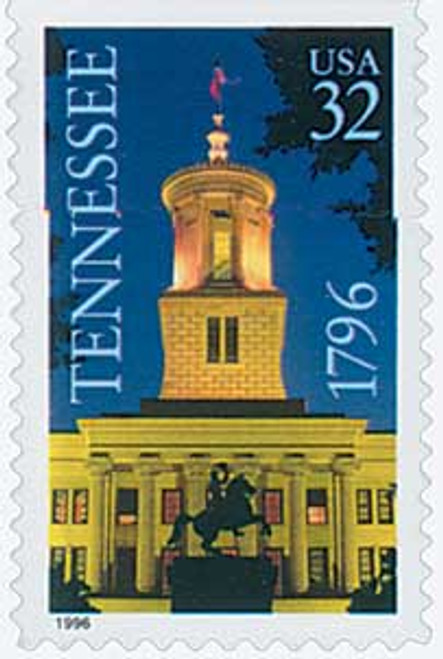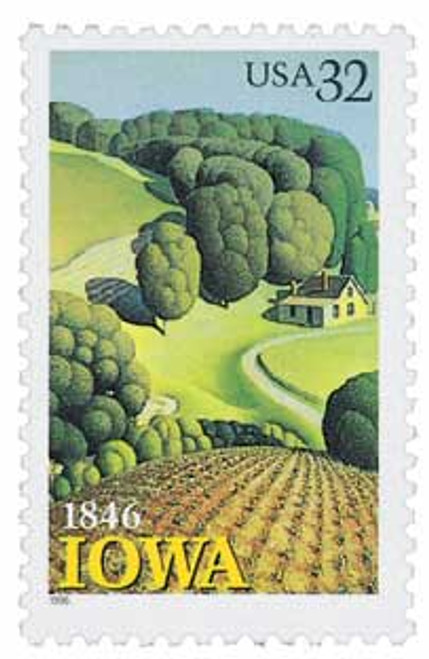
# 3089 FDC - 1996 32c Iowa Statehood, booklet single
US #3089
1996 Iowa Statehood
- First Day Cover
- Honors the 150th anniversary of Iowa’s statehood
- Produced with water-activated and self-adhesive gum
- 2nd US commemorative to be issued in self-adhesive format
Stamp Category: Commemorative
Value: 32¢, First-Class mail rate
First Day of Issue: August 1, 1996
First Day City: Dubuque, Iowa
Printed by: Banknote Corporation of America
Printing Method: Lithographed
Format: Booklet Panes of 20 (5 across, 4 down) from plates of 240 (20 across, 12 down)
Perforations: simulated die cuts
Why the stamp was issued: This stamp was issued to commemorate the 150th anniversary of Iowa becoming the 29th state in the Union.
About the stamp design: The Iowa Statehood stamp’s design shows a detail from a painting by Iowa native, Grant Wood. The painting is titled Young Corn.
Special design details: Three “USPS” inscriptions are microprinted on this stamp as a security measure. One is below the lowest tree on the left side. Another is in the lower right corner of the corn field. The third can only be seen through a blue filter. It is written in yellow on the right side of the sky.
First Day City: The Iowa Statehood stamp was issued in Dubuque, Iowa, home of the state’s first settlement.
About the Printing Process: The Iowa self-adhesive stamp was produced in panes of 20. A narrow strip across the center let the customer fold the pane in half to form a booklet.
Unusual fact about this stamp: The self-adhesive stamp was only sold at post offices in Iowa. Collectors could buy them from the USPS Philatelic Fulfillment Service Center.
History the stamp represents: Iowa’s vast, fertile grasslands are framed by the Missouri River on the west and by the Mississippi River on the east. Though manufacturing and service industries now outrank farming as sources of income, 93% of Iowa’s land and ten percent of its people remain devoted to agriculture. Iowa is “the land where the tall corn grows,” but it is also a leading producer of soybeans and oats, hogs and cattle. In all, Iowa produces seven percent of our nation’s food supply and continues to be one of America’s great and vital farming states.
The explorers Marquette and Jolliet claimed Iowa for France. The territory was transferred to the U.S. in 1803 as part of the Louisiana Purchase. Though French-Canadian Julien Dubuque had settled near the present-day city of Dubuque, Iowa was Indian territory and closed to settlement. After the Black Hawk War of 1832, the tribes sold some land along the Mississippi River. Settlers promptly moved in, and on December 28, 1846, Iowa became our 29th state. Des Moines became Iowa’s capital in 1857.
Iowa boasts a 99% literacy rate, the highest in the land, as well as many famous sons and daughters. Herbert Hoover, our 31st president, and Carrie Chapman Catt, leader in the woman-suffrage movement, are but two Iowans who have enriched American life.
US #3089
1996 Iowa Statehood
- First Day Cover
- Honors the 150th anniversary of Iowa’s statehood
- Produced with water-activated and self-adhesive gum
- 2nd US commemorative to be issued in self-adhesive format
Stamp Category: Commemorative
Value: 32¢, First-Class mail rate
First Day of Issue: August 1, 1996
First Day City: Dubuque, Iowa
Printed by: Banknote Corporation of America
Printing Method: Lithographed
Format: Booklet Panes of 20 (5 across, 4 down) from plates of 240 (20 across, 12 down)
Perforations: simulated die cuts
Why the stamp was issued: This stamp was issued to commemorate the 150th anniversary of Iowa becoming the 29th state in the Union.
About the stamp design: The Iowa Statehood stamp’s design shows a detail from a painting by Iowa native, Grant Wood. The painting is titled Young Corn.
Special design details: Three “USPS” inscriptions are microprinted on this stamp as a security measure. One is below the lowest tree on the left side. Another is in the lower right corner of the corn field. The third can only be seen through a blue filter. It is written in yellow on the right side of the sky.
First Day City: The Iowa Statehood stamp was issued in Dubuque, Iowa, home of the state’s first settlement.
About the Printing Process: The Iowa self-adhesive stamp was produced in panes of 20. A narrow strip across the center let the customer fold the pane in half to form a booklet.
Unusual fact about this stamp: The self-adhesive stamp was only sold at post offices in Iowa. Collectors could buy them from the USPS Philatelic Fulfillment Service Center.
History the stamp represents: Iowa’s vast, fertile grasslands are framed by the Missouri River on the west and by the Mississippi River on the east. Though manufacturing and service industries now outrank farming as sources of income, 93% of Iowa’s land and ten percent of its people remain devoted to agriculture. Iowa is “the land where the tall corn grows,” but it is also a leading producer of soybeans and oats, hogs and cattle. In all, Iowa produces seven percent of our nation’s food supply and continues to be one of America’s great and vital farming states.
The explorers Marquette and Jolliet claimed Iowa for France. The territory was transferred to the U.S. in 1803 as part of the Louisiana Purchase. Though French-Canadian Julien Dubuque had settled near the present-day city of Dubuque, Iowa was Indian territory and closed to settlement. After the Black Hawk War of 1832, the tribes sold some land along the Mississippi River. Settlers promptly moved in, and on December 28, 1846, Iowa became our 29th state. Des Moines became Iowa’s capital in 1857.
Iowa boasts a 99% literacy rate, the highest in the land, as well as many famous sons and daughters. Herbert Hoover, our 31st president, and Carrie Chapman Catt, leader in the woman-suffrage movement, are but two Iowans who have enriched American life.













